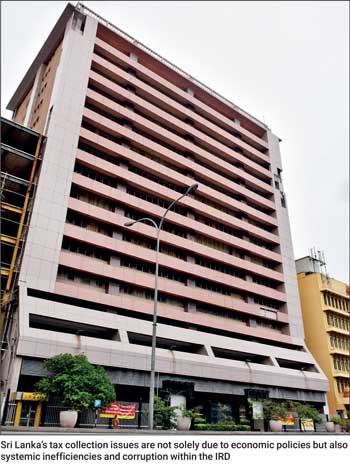Saturday Dec 13, 2025
Saturday Dec 13, 2025
Tuesday, 26 March 2024 00:01 - - {{hitsCtrl.values.hits}}
 The IRD has encountered significant challenges in meeting its tax collection targets. As of October 2023, the IRD collected 82% of the projected revenue, amounting to Rs. 740 billion out of an expected Rs. 908 billion.
The IRD has encountered significant challenges in meeting its tax collection targets. As of October 2023, the IRD collected 82% of the projected revenue, amounting to Rs. 740 billion out of an expected Rs. 908 billion.
The slowdown in collection was particularly noticeable in the second half of the year, attributed to the Central Bank’s interest rate policy directive in August, which impacted corporate tax inflow. Financial institutions, which are major contributors to corporate taxes, have been affected by the monetary policy, leading to a shortfall in Government revenue.
Corporate vs. Non-Corporate Taxes
The IRD set ambitious targets for corporate taxes at Rs. 603 billion and non-corporate taxes at Rs. 305 billion for 2023. By October, 77% of the corporate taxes and 91% of the non-corporate taxes were collected.
The 2024 Budget aims to increase tax revenue to Rs. 4 trillion, up from Rs. 3 trillion in 2023, with a significant portion expected from taxes on income and profit.
Sri Lanka’s tax collection issues are not solely due to economic policies but also systemic inefficiencies and corruption within the IRD. Additionally, the country’s legal framework allows individuals to submit four appeals without paying taxes, leading to a backlog that can take up to 15 years to process.
When compared to other countries with similar GDP per capita, Sri Lanka’s tax to GDP ratio is significantly lower. For instance, Morocco and Georgia, with comparable GDP per capita, collect 24% of GDP as tax revenue, while Sri Lanka collects only 11%. This discrepancy indicates a need for structural reforms to improve tax revenue collection.
 I would like to say, The IRD’s struggle to meet tax collection targets is a multifaceted issue involving economic policies, systemic inefficiencies, and legal frameworks. I would delve into each of these points more thoroughly, discussing the implications of the Central Bank’s policies, the specific challenges faced by different sectors, the strategies proposed by the IRD, and the broader context of tax collection in middle-income countries. Additionally, I would analyse the potential reforms and international best practices that could be adopted to enhance Sri Lanka’s revenue collection efficiency.
I would like to say, The IRD’s struggle to meet tax collection targets is a multifaceted issue involving economic policies, systemic inefficiencies, and legal frameworks. I would delve into each of these points more thoroughly, discussing the implications of the Central Bank’s policies, the specific challenges faced by different sectors, the strategies proposed by the IRD, and the broader context of tax collection in middle-income countries. Additionally, I would analyse the potential reforms and international best practices that could be adopted to enhance Sri Lanka’s revenue collection efficiency.
Systemic issues: The IRD faces several systemic challenges that hinder efficient tax collection:
Inefficiency and corruption: There are reports of inefficiency and corruption among state officials within the IRD, Customs, and Excise Department.
Outdated manual systems: The reliance on manual tax computation systems is a major drawback. This system is full of loopholes and hinders the revenue collection potential.
Resistance to change: Although younger administrators are eager to adopt digital systems, there is resistance among senior officials. Training programs and identifying issues crucial for adopting new systems are necessary steps.
Legal framework: The legal framework in Sri Lanka allows individuals to submit up to four appeals without paying taxes, leading to a backlog that can take up to 15 years to process.
Potential reforms to address these issues; the following reforms could be considered:
Digitalisation: Implementing the full-scale digitalised Revenue Administration Management Information System (RAMIS) connected to Individual financial records could streamline processes and close existing loopholes.
Training and development: Investing in training for IRD officials, especially in digital systems, could help modernise the department and improve efficiency.
Legal reforms: Amending the legal framework to reduce the number of appeals without tax payment and speeding up the processing time could significantly improve revenue collection.
Transparency and accountability: Establishing clear standards for transparency and accountability within the IRD could help combat corruption and inefficiency.
Connecting tax file for today’s requirement: It is a must to keep an active tax file all the time for major financial decisions of all the citizens from capital purchases to asset realisation.
Tax payer incentives: A mechanism to identify and provide a state recognised privilege system will help to attract more tax payers from discounts to priorities at state institutions, healthcare and other major citizen services.
Benefits of digitalisation
Digitalisation in tax collection refers to the process of using digital technologies to enhance the efficiency and effectiveness of tax administration. We can identify the following major benefits from tax digitalisation.
Improved data collection: Digital systems allow tax authorities to collect data more efficiently, leading to better compliance and a broader tax base.
Real-time reporting: Digitalisation enables real-time reporting, which helps in the timely detection and correction of errors.
Enhanced taxpayer services: Digital platforms can offer taxpayers easier access to information and services, improving the overall experience.
Increased transparency: Digital records provide greater transparency in tax transactions, reducing the potential for corruption.
Challenges and considerations
There are many challenges to overcome at the implementation of such a digital infrastructure. It is a policy decision that should be lasting for system change comes with the following challenges.
Technological investment: Tax administrations need to invest in technology to support digitisation efforts.
Change management: Transitioning from manual to digital processes requires careful change management to address resistance and ensure smooth adoption.
Regulatory compliance: Digitisation often requires changes in regulations to support new processes and data formats.
Cybersecurity: Protecting sensitive tax data is paramount, and robust cybersecurity measures are essential in a digital tax system.
Global trends
E-Invoicing: Many countries are adopting e-invoicing to improve indirect tax processes and reduce fraud.
Cashless payments: Many countries are encouraging cashless payment methods for businesses that help to track accurate revenue collection.
Data analytics: Tax authorities are using data analytics to gain insights into taxpayer behavior and identify potential areas of non-compliance.
International cooperation: Digitalisation facilitates better international cooperation in tax matters, helping to address challenges posed by the digital economy.
Impact on tax professionals
The change I am referring to is not in the system of reporting, it is about regulators, operators, administrators and representatives. Tax professionals need to get ready for increasing the accuracy of the accounts they certify. They need to play a major role developing the skills and identifying the role they play.
Skill development: Tax professionals need to develop new skills to work effectively with digital tax systems.
Advisory role: Digitalisation also changes the role of tax advisors, who can now use data to provide more strategic advice on tax planning.
In summary, digitalisation is a powerful tool that can significantly improve tax collection and administration. However, it requires careful planning, investment, and management to realise its full potential.
(The writer is a fellow member of the institute of Chartered Accountants of Sri Lanka and an associate member of Institute of Chartered Accountants of England and Wales having over 15 years professional experience in accounting, finance and tax in Sri Lanka and overseas.)